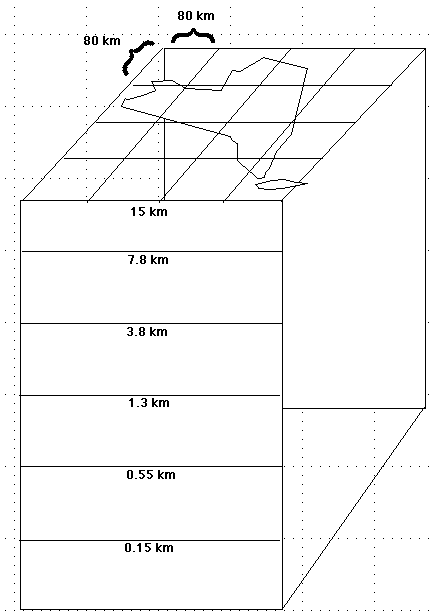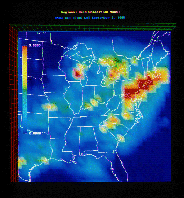| |
|
Regional Acid Deposition Models: Application
The Regional Acid Deposition Model (RADM) is a mesoscale air quality model, developed originally at the National Center for Atmospheric Research (NCAR), with further work being done at the State University of New York and other institutions. RADM's goal is fundamentally to investigate acid deposition (dry and wet) between spatial ranges of 100 - 1000 km. RADM has been used to address questions such as:
- the quantification of acid deposition changes because of emissions control practices
- studies of source-receptor relationships
- transboundary pollution between the United States and Canada
- analysis of emissions trading programs, where industries are allow to "trade" their alloted emissions quotas to other industries.
RADM is an Eulerian grid-based model, designed to incorporate major atmospheric physical and chemical processes related to transport, photochemistry, aqueous chemistry and acidic deposition to provide a scientific basis for estimating the change in regional air concentrations and deposition due to major changes in precursor emissions. RADM's domain of application is eastern North America, from the Rocky Mountains eastward to Newfoundland, including southeastern Canada because the sulfur and nitrogen species time scales in the atmosphere are several days, leading to transport scales of 1,000 kms and more.
| RADM subdivides the atmosphere into 30 x 30 horizontal grid cells, with varying sizes. The graphic at the right (click to see full-size) shows a grid size of 80 x 80 km2. RADM can also be run with horizontal grid sizes of 54, 20, and 18 km2. The graphic shows six vertical layers, with the tops of the layers at 0.15, 0.55, 1.3, 3.8, 7.8, and 15 km. The lowest three layers are roughly within the level of the planetary boundary layer (PBL), which you should recall from the meteorology course, runs approximately up to 2 km. The top three layers are approximately still in the troposphere. The State of New York is shown as an overlay, to remind you that the domain for this particular model is eastern North America. |

|
Like most air quality models, RADM includes several key components common to air quality models and some that are specific to RADM:
- a meteorological model
- emissions inventories (and/or results from emissions models)
- transport and dispersion components
- gas- and aqueous-phase chemical mechanisms
- cloud dynamics algorithms
- calculations of dry and wet deposition
| The central purpose of regional-scale atmospheric transport models like RADM is to directly determine the effects of implementing various emissions reductions programs. The graphic at right shows a still image of a RADM calculation. This graphic shows the concentrations of sulfur dioxide (SO2) as it moves from the Ohio Valley into the northeastern part of the United States. |

|
Confused? Have a question? If so, check out the Frequently Asked Questions (FAQ) page or send mail to the OS411 tutor (os411tutor@shodor.org) with your question!
Report technical/content problems here
|
|